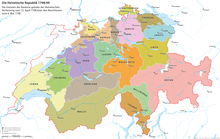County of Baden
County of Baden Grafschaft Baden | |||||||||
|---|---|---|---|---|---|---|---|---|---|
| 1415–1798 | |||||||||
Habsburgs | 1264 | ||||||||
• Established | 1415 | ||||||||
• Disestablished | 1798 | ||||||||
| |||||||||
The County of Baden (German: Grafschaft Baden) was a condominium of the Old Swiss Confederacy and is now part of the Swiss canton of Aargau. The county was established in 1415 after the Swiss conquest of the Aargau and was ruled as a shared condominium until 1798 when it became part of the short-lived Canton of Baden.
History

The land that became the County of Baden was originally ruled by the
On 16 November 1414, Emperor Sigismund called the Council of Constance to settle the Western Schism between the three popes (Benedict XIII, Gregory XII, and John XXIII), all of whom claimed legitimacy. Frederick IV of Habsburg sided with John XXIII. When John XXIII was declared an antipope, he fled the city with Frederick's help. The emperor then declared the Habsburg lands forfeited and ordered the neighbouring countries to conquer those lands for the emperor. The city-state of Bern had already pledged their support of the emperor against the Habsburgs in 1414, and so they were ready to invade. The rest of the Confederation quickly followed.[2]
The territory was quickly conquered in 1415 by the Confederation. Under Habsburg rule, Aargau was divided into multiple sections (
on the left side of the Aare.Initially, ownership of the county was shared between the seven cantons which had participated in the invasion. Starting in 1443 this was expanded into all Eight Cantons or Acht Orte. It was divided into eight inner (Rohrdorf, Birmenstorf, Gebenstorf, Dietikon, Wettingen, Siggenthal, Ehrendingen, Leuggern) and three outer districts (Klingnau, Zurzach, Kaiserstuhl), which included the parishes of Kadelburg, Lienheim and Hohentengen on the right bank of the Rhine.

The Confederates retained much of the Habsburg legal structure, which caused a number of problems. The local nobility had the right to hold the
The governor lived in the Landvogteischloss (Governor's Castle) in Baden, which was expanded in 1486–90. The governor had his own lower court and he was the appellate court for the local lords' courts. He appointed some of the local administrators and the high court judges at Baden. The governor cast the deciding vote in the event of a tie in the high court. Due to the limited jurisdiction and the short, two-year appointment, the governor's power was limited. The local courts and village mayors had quite a bit of autonomy.

The governor's income came from a death tax (converted in 1666 into an annual tax), a tax on people leaving the county, a
Until the 18th century, the vast majority of residents in the county lived off of agriculture. They mostly grew grain, but in the Limmat, Aare and
During the
History since 1798
Canton

The County of Baden was dissolved after the 1798 French invasion. On 19 March 1798, the governments of Zurich and Bern agreed to the creation of the short-lived Canton of Baden in the Helvetic Republic. With the Act of Mediation in 1803, the Canton of Baden was dissolved, becoming part of Aargau.
District
Portions of the lands of the former County of Baden became the District of Baden, firstly in the Canton of Baden and then in the Canton of Aargau (from 1803).
Upon the merging of the canton of Baden into Aargau in 1803, the district gained the municipalities of
After World War II, this formerly agrarian region saw striking growth and became the district with the largest and densest population in the canton (110,000 in 1990, 715 persons per km2).[1]


